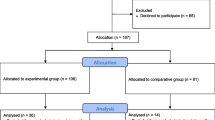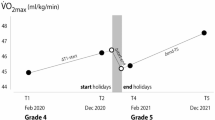Abstract
Few studies have investigated the impact of school-based physical activity interventions on anthropometric characteristics concomitantly with aerobic and anaerobic capacities in young children. The present study aimed to assess the effect of a 6-month physical activity program on body composition and physical fitness among primary schoolchildren. Four hundred fifty-seven children aged 6 to 10 years were randomly assigned to the intervention group (229 children) or observational group (228 children). Participants’ height and weight were assessed, and obesity was determined using French reference curves for BMI. The sum of the four skinfolds and fat-free mass were determined. Ground tests were used to assess aerobic (20-m shuttle run test) and anaerobic (cycling peak power) fitness before and after a 6-month physical activity intervention. The anthropometric modifications obtained over the 6 months cannot be attributed to the intervention as the ANOVA revealed no group effect (intervention vs. group). However, anaerobic and aerobic fitness were significantly improved, thanks to the program in both lean and obese children. A 6-month school-based physical activity intervention in 6- to 10-year-old children did not yield positive anthropometric improvements, but appears effective in terms of aerobic and anaerobic physical fitness. Two physical activity sessions per week in addition to standard physical education classes in primary schoolchildren bring effective results for the prevention of childhood obesity.


Similar content being viewed by others
References
Andersen LB, Harro M, Sardinha LB, Froberg K, Ekelund U, Brage S, Andersen SA (2006) Physical activity and clustered cardiovascular risk in children: a cross-sectional study (The European Youth Heart Study). Lancet 368:299–304
Anderssen SA, Cooper AR, Riddoch C, Sardinha LB, Harro M, Brage S, Andersen LB (2007) Low cardiorespiratory fitness is a strong predictor for clustering of cardiovascular disease risk factors in children independent of country, age and sex. Eur J Cardiovasc Prev Rehabil 14:526–531
Andersen LB, Sardinha LB, Froberg K, Riddoch CJ, Page AS, Andersen SA (2008) Fitness, fatness and clustering of cardiovascular risk factors in children from Denmark, Estonia and Portugal: The European Youth Heart Study. Int J Pediatr Obes 3:58–66
Armstrong N, Welsman JR (1997) Young people and physical activity. Oxford University Press, Oxford
Blair SN, Kohl HW, Barlow CE, Paffenbarger RSJR, Gibbons LW, Macera CA (1995) Changes in physical fitness and all-cause mortality. A prospective study of healthy and unhealthy men. JAMA 273:1093–1098
Bouchard C, Shephard RJ (1994) Physical activity, fitness and health: the model and key concepts. In: Bouchard C, Shephard RJ, Stephens T (eds) Physical activity, fitness, and health: international proceedings and consensus statement. Human Kinetics, Champaign, pp 77–88
Bovet P, Auguste R, Burdette H (2007) Strong inverse association between physical fitness and overweight in adolescents: a large school-based survey. Int J Behav Nutr Phys Act 4:24–32
Brook CGD (1971) Determination of body composition of children from skinfold measurements. Arch Dis Child 46:182–184
Chen JL, Unnithan V, Kennedy C, Yeh CH (2008) Correlates of physical fitness and activity in Taiwanese children. Inter Nurs Rev 55:81–88
Colak R, Ozcelik O (2004) Effects of short-period exercise training and orlistat therapy on body composition and maximal power production capacity in obese patients. Physiol Res 53:53–60
Deforche B, Bourdeaudhuij I, Debode P, Vinaimont F, Hills AP, Verstraete S, Bouckaert J (2003) Changes in fat mass, fat-free mass and aerobic fitness in severely obese children and adolescents following a residential treatment programme. Eur J Pediatr 162:616–622
Dobbins M, DeCorby K, Robeson P, Husson H, Tirilis D (2009) School-based physical activity programs for promoting physical activity and fitness in children and adolescents aged 6–18. Cochrane Databas Syst Rev 1:CD007651
Doré E, Diallo O, Franca NM, Bedu M, Van Praagh E (2000) Dimensional changes cannot account for all differences in short-term cycling power during growth. Int J Sports Med 21:360–365
Falls IIB, Humphrey LD (1976) Energy cost of running and walking in young women. Med Sci Sports 8:9–13
Flynn MA, McNeil DA, Maloff B, Mutasingwa D, Wu M, Ford C, Tough SC (2006) Reducing obesity and related chronic disease risk in children and youth: a synthesis of evidence with ‘best practice’ recommendations. Obes Rev 7(Suppl 1):7–66
Gerber A, Predel H-G, Dordel S (2008) School-based prevention: effects on obesity and physical performance after 4 years. J Sports Sci 26(10):987–994
Gorely T, Nevill ME, Morris JG, Stensel DJ, Nevil A (2009) Effect of a school-based intervention to promote healthy lifestyles in 7–11 year old children. Inter J Beha Nutr Phys Act 6:5
Graft C, Koch B, Falkowskif G, Jouck S, Christ H, Staudenmaier K, Tokarskiw W, Jebb SA, Moore MS (1999) Contribution of a sedentary lifestyle and inactivity to the etiology of overweight and obesity: current evidence and research issues. Med Sci Sports Exerc 31(Suppl 11):S534–S541
Harris KC, Kuramoto LK, Schulzer M, Retallack JE (2009) Effect of school-based physical activity interventions on body mass index in children: a meta-analysis. CMAJ 180(7):719–726
Knöpfli BH, Radtke T, Lehmann M, Schätzle B, Eisenblätter J, Gachnang A, Wiederkehr P, Hammer J, Brooks-Wildhaber J (2008) Effects of a multidisciplinary inpatient intervention on body composition, aerobic fitness, and quality of life in severely obese girls and boys. J Adolesc Health 42:119–127
Korsten-Reck U, Kaspar T, Korsten K, Kromeyer-Hausechild K, Bos K, Berg A, Dickhuth HH (2007) Motor abilities and aerobic fitness of obese children. Int J Sports Med 28(9):762–767
Kriemler S, Zahner L, Schindler C, Meyer U, Hartmann T, Hebestreit H, Brunner-La Rocca HP, van Mechelen W, Puder JJ (2010) Effect of school based physical activity programme (KISS) on fitness and adiposity in primary schoolchildren: cluster randomised controlled trial. BMJ 340:c785
Lafortuna CL, Fumagalli E, Vangeli V, Sartorio A (2002) Lower limb alactic anaerobic power output assessed with different techniques in morbid obesity. J Endocrinol Investig 25:134–141
Lazaar N, Aucouturier J, Ratel S, Rance M, Meyer M, Duché P (2007) Effect of physical activity intervention on body composition in young children: influence of body mass index status and gender. Acta Paediatr 96:1315–1320
Lee CD, Jackson AS, Blair SN (1998) US weight guidelines: is it also important to consider cardiorespiratory fitness? Int J Obes Relat Metab Disord 22(Suppl 2):S2–S7
Léger L, Lambert J, Mercier D (1983) Predicted VO2 max and maximal speed for a multistage 20-rn shuttle run in 7000 Quebec children aged 6–17. Med Sci Sports Exerc 15:142–143
Léger LA, Mercier D, Gadoury C, Lambert J (1988) The multistage 20 metre shuttle run test for aerobic fitness. J Sports Sci 6(2):93–101
Lohman TG, Roche AF, Martorel R (eds) (1998) Anthropometric standardization reference manual. Human Kinetics, Champaign
Maffeis C, Zaffanello M, Schutz Y (1997) Relationship between physical inactivity and adiposity in prepubertal boys. J Pediatr 131:288–292
Matvienko O, Ahrabi-Fard I (2010) The effect of a 4-week after school program on motor skills and fitness of kindergarden and first grade students. Am J Health Promot 24(5):299–303
Menier DR, Pugh LG (1968) The relation of oxygen intake and velocity ofwalking and running in competitive walkers. J Physiol 197:717–721
Ozcelika O, Doganb H, Kelestimur H (2006) Effects of eight weeks of exercise training and orlistat therapy on body composition and maximal exercise capacity in obese females. Public Health 120:76–82
Roland-Cachera MF, Cole TJ, Sempe M, Tichet S, Rossignol C, Charraud A (2001) Body mass index variations: centiles from birth to 87 years. Eur J Clin Nutr 45:13–21
Shang X, Ailing L, Yanping L, Xiaoqi H, Lin D, Jun M, Guifa X, Ying L, Hongwei G, Guangsheg M (2010) The association of weight status with physical fitness among Chinese children. Int J Pediatr 2010:515–414
Slentz CA, Houmard JA, Johnson JL, Bateman LA, Tanner CJ, McCartney JS, Duscha BD, Kraus WE (2007) Inactivity, exercise training and detraining, and plasma lipoproteins. STRRIDE: a randomized, controlled study of exercise intensity and amount. J Appl Physiol 103:432–442
Susuki M, Tatsumi M (1993) Effect of therapeutic exercise on physical fitness in a school health program for obese children. Nippon Koshu Eisei Zasshi 40(1):17–18
Tomkinson GR, Léger LA, Olds TS, Cazorla G (2003) Secular trends in the performance of children and adolescents (1980–2000): an analysis of 55 studies of the 20 m shuttle run test in 11 countries. Sports Med 33:285–300
Watts K, Beye P, Siafarikas A, O’Driscoll G, Jones TW, Davis EA, Green DJ (2004) Effects of exercise training on vascular function in obese children. J Pediatr 144:620–625
Watts K, Jones TW, Davis EA, Green D (2005) Exercise training in obese children and adolescents: current concepts. Sports Med 35:375–392
Wong PCH, Chia MYH, Tsou IYY, Wansaicheong GKL, Tan B, Wang JCK, Tan J, Kim CG, Boh G, Lim D (2008) Effects of a 12-week exercise training programme on aerobic fitness, body composition, blood lipids and C-reactive protein in adolescents with obesity. Ann Acad Med Singapore 37:286–293
Acknowledgments
This study was funded by grants from the French National Plan for Nutrition and Health (PNNS), the Comite Regional Executif des Actions de Sante d’Auvergne (CREAS), the Caisse Régionale d’Assurance Maladie d’Auvergne (CRAMA), the Appert Institutes, the town of Clermont-Ferrand, and the governing bodies of the Clermont-Ferrand school system.
The authors would like to thank the school boards and the participants for their patience, time, and effort. The authors also wish to thank Professor Mario Bedu, who was in charge of the research design.
Author information
Authors and Affiliations
Corresponding author
Rights and permissions
About this article
Cite this article
Thivel, D., Isacco, L., Lazaar, N. et al. Effect of a 6-month school-based physical activity program on body composition and physical fitness in lean and obese schoolchildren. Eur J Pediatr 170, 1435–1443 (2011). https://doi.org/10.1007/s00431-011-1466-x
Received:
Accepted:
Published:
Issue Date:
DOI: https://doi.org/10.1007/s00431-011-1466-x




